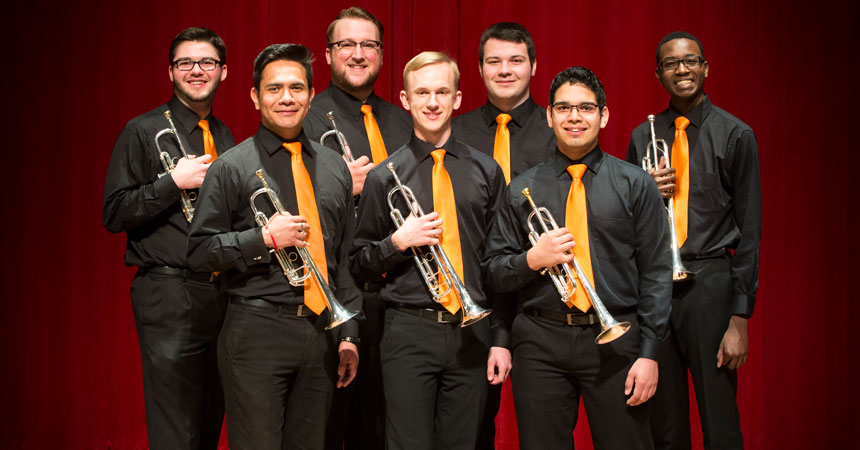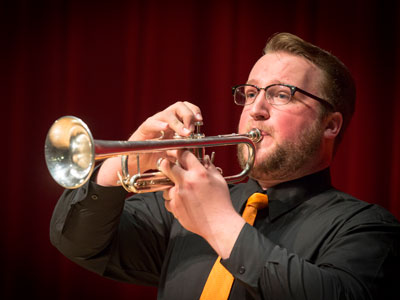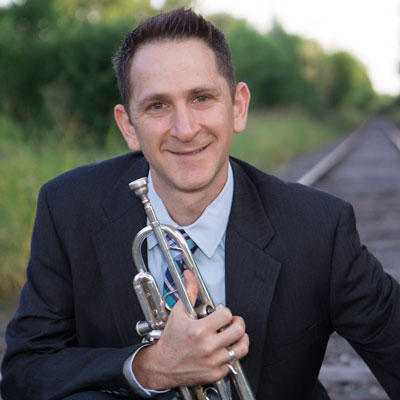Blowing Them Away
Tuesday, March 21, 2017

Editor’s Note: Grant Harper is an OSU senior, majoring in trumpet performance and vocal music education. He kept a travel log for A&S magazine during his recent trip to the National Trumpet Competition. The highlights follow:
Day 1
NTC: The National Trumpet Competition. This year, Columbus State University in Georgia graciously played host. Hundreds of soloists and ensembles ranging from junior high to graduate students showcased their talents for the best players and teachers from across the country.
For us, the students of Oklahoma State University, NTC has become an annual trip. In 2016, four soloists (two undergraduate and two graduate) and three ensembles were competing. Dr. Ryan Gardner, our teacher and ensemble coach, has built an NTC dynasty at OSU.
We have been preparing for this competition since August, and finally the day came for us to depart. Tuesday, March 8, began with every member of the trumpet studio meeting at the Seretean Center to load cars and head to the Tulsa airport. We arrived in Atlanta around 5 p.m. Eastern, rented cars and got on the road to Columbus. My car was filled with a great amount of enlightening conversation as well as the 1979 recording of Leonard Bernstein conducting a performance of Symphony No. 5 by Shostakovich with the New York Philharmonic. We have to be nerds somehow.
After checking into our hotel and getting dinner, we found a janitor who opened the orchestra room at CSU for our rehearsal. All three groups ran our competition day routine: small spots from our pieces followed by full runs. The Silver Ensemble, a quartet, begins with their arrangement of J.S. Bach’s Prelude and Fugue in G minor. Next, the Black Ensemble, a septet that I am in, hits our problem spots and performs a full run, an arrangement of Rimsky-Korsakov’s Russian Easter Overture, arranged by Dr. Gardner. Finally, the Orange Ensemble, a quintet that is performing “Bacchanale” from Camille Saint-Saens’ opera Samson et Delila, thought that they would do spot checks, but instead they cranked out the best full run of their piece to date! So we packed up and called it a night.

Day 2
Day 2 of our trip was much more relaxed, with no flying and minimal driving. The only thing on our minds was the competition. One day left to improve and solidify our ensembles. Morning rehearsals at CSU were simple: spot checks and runs. All three groups came in, acted like it was the actual competition day, and each group performed wonderfully.
After lunch, Dr. Gardner, the four soloists and I returned to CSU to rehearse with pianists. Each soloist had 30 minutes with a pianist to rehearse — the only time the soloists get to work with the pianists until they take the stage on Friday. The times were all back-to-back, and we returned to the hotel around 4:30 p.m.
During our second rehearsal of the day, all three groups performed well, but we each needed to work on intonation and being together throughout the entire piece.
After dinner (capped off by a cookie sundae and a “Happy Birthday” serenade to me on my 22nd birthday), we settled in for the evening, all of us feeling some level of nerves over tomorrow’s competition.
Day 3
Competition day has arrived for the ensemble division semifinalists.

“Next to perform, the Oklahoma State University ensemble performing Russian Easter Overture by Rimsky-Korsakov, arranged by Gardner.”
Sophomore Kevin Kamau led us onto stage. We looked out into a 2,000-seat hall that dwarfs the Seretean Concert Hall of only 800. Lorenzo Diaz, a second-year master’s student, leads our bow. I heard the breathing of everyone down the line: a bit shallow but still confident. Freshman Ian Mertes began the piece, and we took off. Seven and a half minutes later, we finished with our unison D, hearing our sounds resonate for what seems like ages. The audience erupts. Now it was up to the judges to decide if we were good enough to make the cut.
When the OSU quartet finally took the stage, our nerves were a little visible from the audience. Sophomore Bryson Tuttle, who began completely alone, had shaking hands. The performance went wonderfully as the group put more music into a Bach prelude and fugue than should be allowed.
We headed back into Legacy Hall to prepare for our quintet’s performance. This group being the reigning national champions, the crowd grew. The group was greeted by a large gust of applause and cheering. By the end of the piece, no one could believe what was just heard. The sounds filled Legacy Hall for several seconds after the cutoff. It was phenomenal.
As the opening concert was coming to a close, the audience got more and more antsy, awaiting the results. Finally, an NTC board member took the stage: “The Large Ensemble finalists are the University of Texas, Oklahoma State University and Central Michigan University.”
Day 4
With the ensemble competition over with, we looked forward to a more relaxed day going to the exhibits and listening to solo performances.
The exhibits are a special part of the competition. Companies that produce everything trumpet show up with their shiniest and best products to tout to young musicians looking to push their playing to the next level. Many times, students will walk out with new horns. It is also a good time for teachers to try horns that they may want to buy for their schools. Dr. Gardner goes straight to the source for us. He is a Bach performing artist, so he makes the exodus to the Bach factory to try out horns that his students will get to play for free when we’re at the school. However, this is a great place for the students to try out horns on their own.
With our experiences at the exhibits wrapped up, we began our first of four competitors in the solo division. First up was Lorenzo Diaz, a second-year master’s student from Duncan, Okla., who is also a part of the large ensemble. He stepped on stage in a regal purple button-down shirt and played The American Concerto by Ellen Taafe Zwilich. It’s not a very well-known piece of music, but it is one of the hardest from the modern repertoire.
Next was Justin Weisenborn, a first-year master’s student and member of OSU’s quintet. He performed the Tamberg Trumpet Concerto, another of the hardest pieces in the modern repertoire. Tyler Murray was the last of the four OSU performers for the day. The senior from Checotah, Okla., filled much of the 2,000-seat concert hall with his sound.
Day 5
Dr. Gardner asked us to attend the high school semi finals around 11:30 a.m. to hear some prospective OSU students. The three were really talented and impressed us greatly, playing pieces that some of us college students would not dare to play because of their level of difficulty.
A short lunch later, performance preparations swung into high gear.
We struggled to find an open room suitable for warm-ups, which didn’t help the tension level among us. The 10 minutes we were to get in our official warm-up room didn’t help that much; room monitors interrupted us every couple of minutes to count down how little time we had left to prepare in there.
The University of Texas Trumpet Ensemble preceded us on stage. Its wonderful performance motivated us further. I took the stage with the ensemble, feeling confident and knowing we would do well.
Ian Mertes began our piece, and from the first note I could tell something was wrong: There was a weird fuzz in his sound. After the longest eight minutes of my life, we finished our run. There were lots of little mistakes (slight timing errors, chipped notes, chords not as well in tune) but no glaring problems, and for that I was grateful.
After getting coffee and a little shopping, we returned to the RiverCenter to hear the graduate and undergraduate solo finalists as our Justin Weisenborn was one. His second run of the Tamberg Concerto was even better than the day before. I knew that he would be hard to beat — and he won the Graduate division of NTC.
A little while later, another announcement regarding the Maller Trumpet Large Ensemble Division:
“In first place, with a cash prize of $5,000, Oklahoma State University.”
Photo Courtesy / Phil Shockley
Story by Grant Harper
